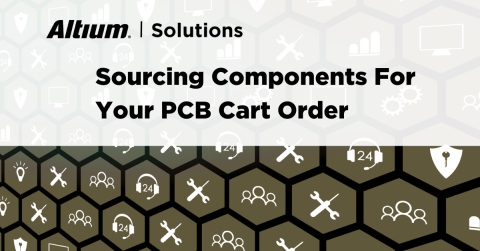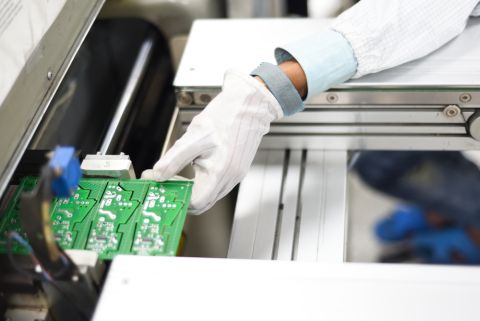The Benefits of a Circular Economy for Electronics

The concept of a circular economy for electronics is a transformative approach to production and consumption. It emphasizes the reuse, repair, refurbishment, and recycling of electronic products to create a closed-loop system, minimizing waste and the use of finite resources. This article explores the key benefits of advancing a circular economy for electronics, and what this translates to in tangible measures (figure 1). It also covers actions that electronics businesses can take on the journey to creating a leading circular supply chain.

Figure 1: Measurable % benefits of the circular economy for electronics
Benefit 1: Reduction in E-Waste
The circular economy model can significantly reduce electronic waste (e-waste), which is one of the fastest-growing waste streams globally. By designing electronics for longevity, encouraging repairability, and facilitating recycling, we can decrease the volume of e-waste. For instance, the implementation of modular design allows for easier upgrades and repairs, potentially reducing e-waste by up to 50% according to Circular Electronics Partnership.
The circular economy model offers a promising solution to this problem by promoting the reduction, reuse, and recycling of electronics. Businesses can play a pivotal role in this transformation by adopting practices that contribute to e-waste reduction.

Actions to Take
Design for Longevity: Implement modular designs in products to facilitate easy upgrades and repairs. Use standardized components to increase compatibility and interchangeability and incorporate robust materials that extend the product’s life.
Encourage Repairability: Provide repair manuals and online guides to assist consumers in fixing products. Offer repair services or partnerships with local repair shops and design products with easy disassembly in mind to simplify the repair process.
Facilitate Recycling: Establish take-back programs for end-of-life electronics. Partner with certified e-waste recyclers to ensure responsible recycling practices and use recyclable materials and minimize the use of hazardous substances and facilitate the recycling process.
Educate Consumers: Launch awareness campaigns about the benefits of a circular economy and provide information on recycling centers and collection points. Encourage the return of old devices by offering discounts on new purchases.
Innovate in Product Service Systems: Develop leasing models where consumers pay for the service rather than owning the product. Offer subscription services for regular updates and maintenance.
Policy Advocacy: Support legislation that promotes product longevity and repairability. Engage in industry collaborations to set standards for circular design.
Invest in Other Circular Supply Chains: Source refurbished components for new products. Collaborate with suppliers who practice circular economy principles.
By implementing these steps, businesses can significantly reduce e-waste. Modular design alone can lead to a 50% reduction in waste. The cost savings from waste management and material costs are estimated at 30%, which can be a substantial margin for businesses. Moreover, companies that adopt these practices may see an increase in consumer trust and brand loyalty, leading to long-term profitability.
The reduction of e-waste is not only an environmental imperative but also a business opportunity. By taking specific, actionable steps towards a circular economy, businesses can reap financial benefits while contributing to a more sustainable world. The Circular Electronics Partnership’s roadmap provides a valuable framework for companies to follow, ensuring that the electronics industry moves towards a future where e-waste is minimized, and resources are used efficiently. The journey towards e-waste reduction is a collective effort that requires commitment, innovation, and collaboration across all sectors of society.

Benefit 2: Conservation of Resources
Electronics manufacturing is resource-intensive, often involving rare and precious metals. A circular approach conserves these valuable materials by recovering and reusing components. The Circular Electronics Partnership (CEP) outlines actions to maximize the value of products throughout their lifecycle. This can lead to a reduction in the demand for virgin materials by up to 32%, translating into a cost saving of approximately 25% due to decreased raw material expenses.
A circular economy approach not only conserves these materials but also ensures their continued availability for future generations.
Actions to Take
Sustainable Material Sourcing: Prioritize recycled materials over virgin resources in manufacturing. Engage in responsible mining practices for necessary virgin materials for components. This can be done by developing relationships with suppliers who are committed to sustainable practices.
Design for Disassembly and Reuse: Create products that can be easily disassembled for material recovery. Use connectors instead of glues to facilitate component separation and label materials clearly for efficient sorting and recycling.
Component Recovery and Recycling: Invest in advanced recycling technologies that can recover more materials and set up dedicated facilities for component refurbishment. Implement a reverse logistics network to bring back end-of-life products.
Product Life Extension: Offer upgrade options for existing devices to extend their usability. Provide software updates that maintain device functionality over time. Encourage consumers to opt for repairs rather than replacements.
Circular Business Models: Adopt product-as-a-service models where customers lease rather than own electronics. Implement buy-back or trade-in programs for older devices and explore remanufacturing to give products a second life.
Innovation in Manufacturing Processes: Reduce material usage through efficient design and manufacturing techniques. Utilize 3D printing to create parts on demand, reducing inventory and waste. Invest in renewable energy sources for manufacturing operations.
Adopting these measures can lead to a significant reduction in the use of virgin materials. This also alleviates the strain on natural resources and translates into cost savings due to decreased expenses on raw materials. Moreover, businesses that move towards resource conservation can benefit from enhanced brand reputation and customer loyalty, which can indirectly contribute to increased sales and market share.
Conserving resources through a circular economy is not just an environmental imperative; it’s a strategic business decision. By taking concrete steps to recover and reuse components, businesses can reduce their environmental impact while also achieving financial savings. The Circular Electronics Partnership provides a framework for action, but it is up to individual companies to take the initiative and lead the way in sustainable electronics manufacturing. The transition to a resource-conserving, circular model is an investment in the future of both the planet and the electronics industry.

Benefit 3: Energy Efficiency and Carbon Footprint Reduction
Circular electronics contribute to energy efficiency by extending product lifespans and reducing the need for the production of new units. The European Union's eco-design requirements aim to improve product durability and reparability, which can lead to a 15-30% reduction in energy consumption over a product's lifetime. This energy saving translates to a reduction in carbon footprint and can offer a cost benefit of around 20% when considering the full lifecycle of electronic products.
Energy efficiency in the electronics industry is crucial for reducing operational costs and mitigating environmental impact. Circular electronics, which prioritize the extension of product lifespans and the reduction of production for new units, play a significant role in achieving these goals. The European Union’s eco-design requirements are a testament to the commitment to improve product durability and reparability, leading to substantial energy savings.
Actions to Take
Eco-Design and Product Durability: Adopt eco-design principles that focus on energy efficiency and durability. Design products for longevity, using durable materials and construction methods that can withstand regular use. Incorporate energy-saving features such as low-power modes and efficient power supplies.
Repair and Maintenance: Facilitate easy repairs by designing products with replaceable components and providing access to repair manuals. Establish a network of repair services, either in-house or through partnerships, to maintain product functionality. Offer extended warranties that cover repairs, encouraging customers to fix rather than replace products.
Software Optimization: Provide regular software updates that enhance performance and energy efficiency. Develop power management software that optimizes energy consumption based on usage patterns. Encourage consumers to update their devices, ensuring they benefit from the latest energy-saving technologies.
Renewable Energy Use: Power manufacturing facilities with renewable energy to reduce the carbon footprint of production. Invest in renewable energy certificates or carbon offsets for energy used in operations. Promote the use of renewable energy among suppliers and partners.
Supply Chain Management: Evaluate the energy efficiency of the supply chain and work with suppliers to reduce energy use. Optimize logistics to minimize transportation distances and associated energy consumption. Source locally, when possible, to reduce the carbon footprint of shipping and handling.
Consumer Engagement: Educate consumers on the energy and environmental benefits of circular electronics. Promote energy-efficient usage habits such as unplugging devices when not in use. Engage customers in sustainability initiatives, such as recycling drives and eco-friendly product launches.
By implementing these strategies, businesses can expect a reduction in energy consumption over the lifetime of their products. This reduction translates into a cost benefit, considering the full lifecycle of electronic products. Additionally, the decrease in energy use directly contributes to a lower carbon footprint, which is increasingly valued by consumers and stakeholders.
Energy efficiency and carbon footprint reduction are not only beneficial for the environment but also offer significant cost savings for businesses. By taking proactive steps towards circular practices, companies can enhance their market position, meet regulatory requirements, and contribute to a more sustainable electronics industry. The transition to energy-efficient and low-carbon operations is an investment in the future, aligning business objectives with the urgent need to address climate change.

Benefit 4: Economic Growth and Job Creation
Transitioning to a circular economy can stimulate economic growth by creating new business opportunities and jobs in the repair, refurbishment, and recycling sectors. The CEP roadmap suggests that circular business models could generate a 5% increase in GDP and create millions of new jobs worldwide. The cost benefit here is not just monetary but also social, with a potential increase in employment rates and economic resilience.
The shift towards a circular economy in the electronics sector is not only an environmental imperative but also a catalyst for economic growth and job creation. By rethinking and redesigning the way we produce and consume electronics, businesses can unlock new opportunities for innovation and employment.
Actions to Take
Develop Repair and Refurbishment Services: Establish repair centers to extend the life of electronic products. Train technicians in specialized repair and refurbishment skills. Offer warranty extensions and maintenance contracts to encourage product longevity.
Create Recycling Programs: Implement in-store recycling drop-offs for consumers to return used electronics and develop partnerships with local recycling facilities to process e-waste responsibly. Invest in recycling technology to recover valuable materials from old electronics.
Innovate in Product Design: Adopt design for disassembly in new products to facilitate future recycling. Engage in research and development for sustainable materials and production processes. Collaborate with designers to create aesthetically pleasing, durable, and recyclable electronics.
Foster a Circular Business Culture: Educate employees about the principles and benefits of a circular economy. Incentivize circular practices within the company through recognition and rewards. Adopt circular procurement policies to support other businesses in the circular economy.
Engage with Stakeholders: Work with government bodies to shape policies that support circular economy initiatives. Participate in industry forums to share knowledge and collaborate on circular strategies. Involve customers in the development of circular products and services.
Explore New Business Models: Offer leasing or renting options for electronics to reduce the need for ownership. Develop subscription services for regular updates and maintenance. Introduce trade-in programs to encourage consumers to return their old devices.
Invest in Local Economies: Source materials and labor locally to reduce transportation costs and support community businesses. Collaborate with educational institutions to develop training programs for circular economy jobs. Support local initiatives that promote sustainability and circular economy practices.
Transitioning to a circular economy model can lead to an increase in GDP and create millions of new jobs globally. The social cost benefits include increased employment rates and enhanced economic resilience. Businesses that adopt circular practices can also see improvements in employee engagement and customer loyalty, which can translate into long-term financial gains.
The advancement of a circular economy for electronics presents significant opportunities for economic growth and job creation. By implementing the tangible actions outlined above, businesses can contribute to a thriving economy that values sustainability and innovation. The Circular Electronics Partnership’s roadmap offers a strategic direction for this transition, but it is the collective effort of businesses, governments, and consumers that will drive the change towards a more sustainable and prosperous future.

Benefit 5: Consumer Engagement and Brand Loyalty
Companies that adopt circular practices often see increased consumer engagement and brand loyalty. Customers are increasingly aware of environmental issues and prefer brands that demonstrate sustainability. A circular economy approach can enhance a company's reputation, leading to a potential 10-15% increase in sales. The cost benefit in terms of customer retention and acquisition can be significant, with some estimates suggesting a 20% increase in long-term profitability.
In today’s market, consumer engagement and brand loyalty are invaluable assets for any business. With a growing consciousness about environmental sustainability, customers are gravitating towards brands that align with their values. Companies that adopt circular practices not only contribute to the environment but also build a strong, loyal customer base.
Actions to Take
Communicate with Transparency: Disclose sustainability efforts and achievements in clear, accessible language. Use social media and marketing to share stories of circular practices and their impact. Publish sustainability reports to demonstrate progress and commitment.
Involve Customers: Create platforms for customer feedback on product design and sustainability initiatives. Involve customers in the product lifecycle, such as sending back used products for recycling or refurbishment. Organize community events like recycling drives or educational workshops.
Increase Sustainable Products Offerings: Develop eco-friendly product lines that use recycled materials or are designed for longevity. Highlight the environmental benefits of products in marketing campaigns. Offer incentives for customers who choose sustainable options.
Deploy Loyalty Programs: Implement loyalty programs that reward sustainable purchasing behaviors. Provide discounts or benefits for customers who participate in recycling or trade-in programs. Tailor rewards to encourage long-term engagement with the brand’s sustainability efforts.
Build Partnerships and Collaborations: Collaborate with environmental organizations to gain credibility and visibility. Partner with other sustainable brands to offer bundled products or services. Engage in cross-promotional activities that highlight shared values and commitments.
Innovate in Service Delivery: Offer digital services that reduce the need for physical products, such as cloud storage or streaming. Develop apps or tools that help customers track their environmental impact. Provide virtual assistance for product setup, troubleshooting, and repair guidance.
Build a Community: Foster an online community around sustainability topics related to the brand. Encourage user-generated content that showcases the use of sustainable products. Create a sense of belonging among customers by recognizing their contributions to sustainability.
By engaging consumers and fostering brand loyalty through circular practices, companies can experience an increase in sales. Furthermore, the focus on customer retention and acquisition can lead to an increase in long-term profitability. These benefits underscore the financial viability of integrating circular economy principles into business strategies.
Consumer engagement and brand loyalty are critical components of business success in the circular economy. By taking the tangible actions outlined above, businesses can deepen their relationships with customers, enhance their brand reputation, and achieve significant economic benefits. The journey towards a circular economy is not only an environmental or economic choice but also a strategic move to win the hearts and minds of consumers worldwide.
Conclusion
Advancing a circular economy for electronics presents a compelling case for environmental sustainability and economic viability. The benefits range from reducing e-waste and conserving resources to improving energy efficiency, fostering economic growth, and enhancing consumer relations. With the right policies, industry collaboration, and consumer participation, the transition to a circular economy for electronics can yield substantial cost benefits and contribute to a more sustainable future.










